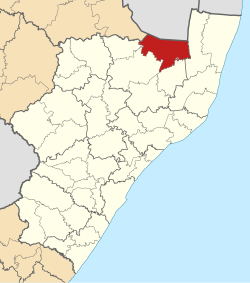UPhongolo Local Municipality
| uPhongolo | ||
|---|---|---|
| Local municipality | ||
|
||
 Location of UPhongolo Local Municipality within KwaZulu-Natal |
||
| Coordinates: 27°23′S 31°37′E / 27.383°S 31.617°ECoordinates: 27°23′S 31°37′E / 27.383°S 31.617°E | ||
| Country | South Africa | |
| Province | KwaZulu-Natal | |
| District | Zululand | |
| Seat | Pongola | |
| Wards | 14 | |
| Government | ||
| • Type | Municipal council | |
| • Mayor | Mr B Mncwango (2007) | |
| Area | ||
| • Total | 3,239 km2 (1,251 sq mi) | |
| Population (2011) | ||
| • Total | 127,238 | |
| • Density | 39/km2 (100/sq mi) | |
| Racial makeup (2011) | ||
| • Black African | 98.1% | |
| • Coloured | 0.1% | |
| • Indian/Asian | 0.1% | |
| • White | 1.5% | |
| First languages (2011) | ||
| • Zulu | 94.0% | |
| • Afrikaans | 1.5% | |
| • Southern Ndebele | 1.2% | |
| • English | 1.1% | |
| • Other | 2.2% | |
| Time zone | SAST (UTC+2) | |
| Municipal code | KZN262 | |
uPhongolo Local Municipality, is a local municipality in the northern area of Zululand, in the South African province of KwaZulu-Natal.
In 2007, the uPhongolo Municipality contained 154 rural shops, 124 schools, 27 hotels, resorts or conference facilities, 15 clinics, 12 recreational facilities, 6 community halls, 4 post offices, 2 police stations, and 2 law courts. The municipality is largely composed of traditional areas, with tribal land patterns and high density rural settlements. 82% of the population lives in rural areas.
The N2 national road corridor passes through the uPhongolo area as a national link between Gauteng and the Richards Bay complex, and on to Durban in the south. It also connects with Swaziland just to the north of the uPhongolo Municipal area. This is the primary development corridor in uPhongolo.
The two main rivers in the municipality are the Mkuze River in the south and the Phongolo River in the north, the latter feeding the Pongolapoort Dam, located on the eastern boundary of the municipality.
The Phongolo River rises just east of Wakkerstroom and drains an area of nearly 8,000 km² where the rainfall often exceeds 1,000 mm a year. Because the irrigation weir at Pongola could not fully regulate the river's erratic water flow, the 89-meter-high Pongolapoort Dam wall was built in 1972 in a narrow gorge in the Lebombo Mountains. Phongolo is the Zulu word for "trough," referring to the many deep pools with steep sides along the river's course.
Agriculture and tourism form the basis for the municipality’s economy. Major development components consist of game and nature reserves, agricultural activities, traditional settlement areas and some urban nodes.
The public sector is the dominant provider of employment opportunities. However, the informal sector is expanding, primarily based on the taxi industry, informal financial services and taverns.
...
Wikipedia

